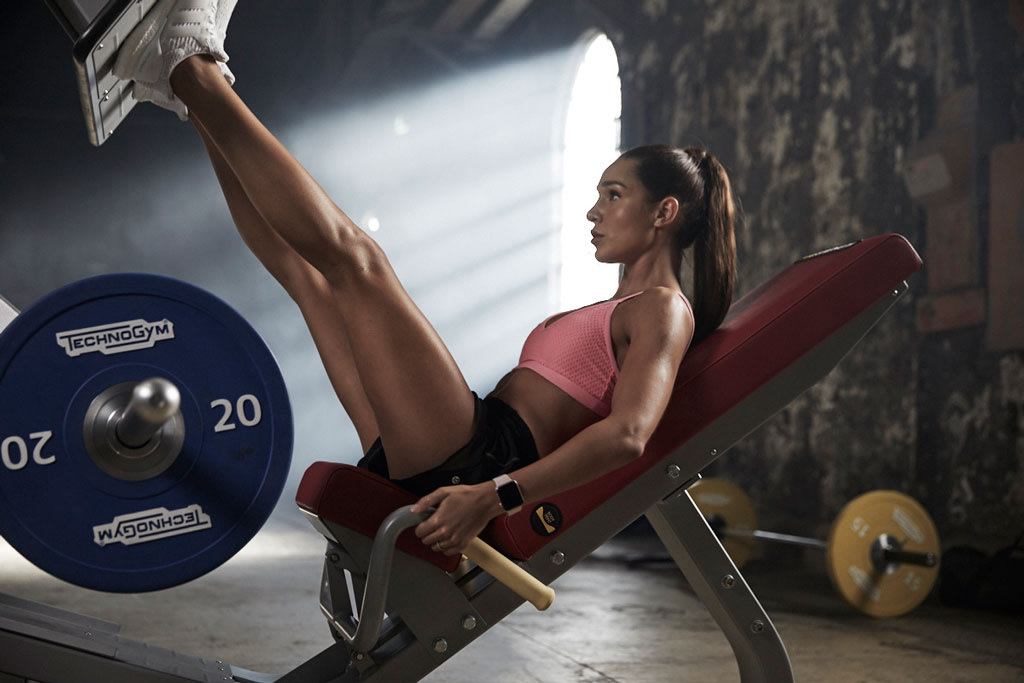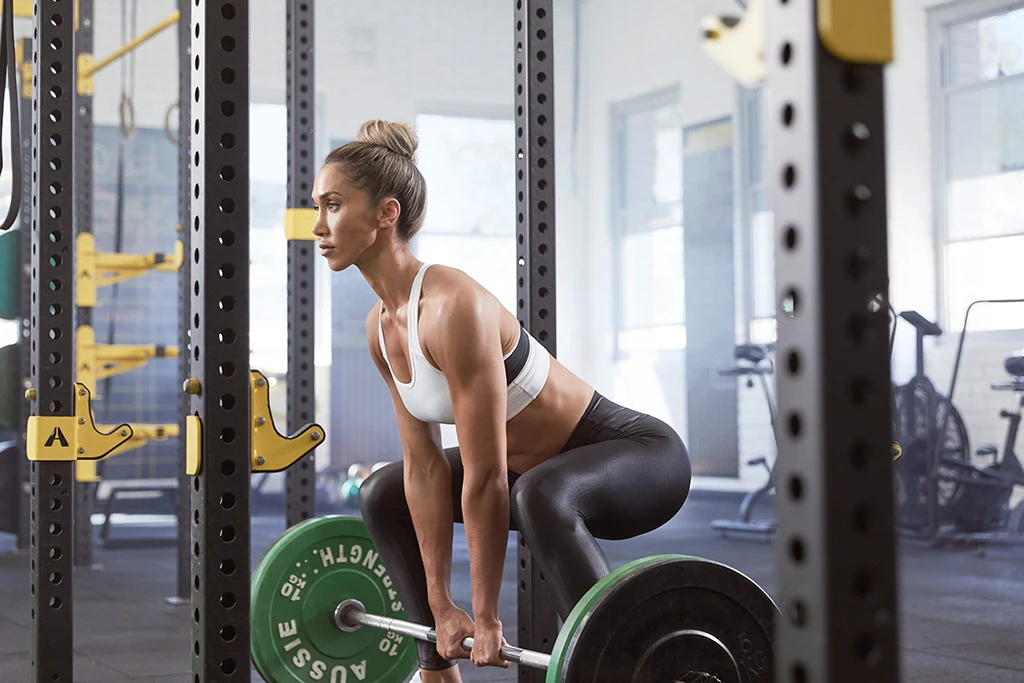20 Best Leg Exercises For Women: Home & Gym

November 8, 2019

So you’re looking for the best leg exercises to start smashing out amazing leg workouts and build your lower body strength? You’ve come to the right place!
Building your leg muscles is a key part of many fitness goals — whether you are a runner, you feel your most powerful lifting weights or you love high-intensity interval training! Knowing the best exercises to add to your workouts can take the guesswork out of leg day. Stronger levels and improved muscular endurance, here we come.
Find out:
Benefits of leg workouts
Your legs are made up of some of your largest muscles, which support you during most of your daily activities and everyday movements.
Having stronger leg muscles can make it easier to walk, run, jump, lunge, squat down and balance, as well as help to build stronger bones, reduce your risk of injury, and improve your overall fitness and workout performance. There are so many benefits!
The American Academy of Orthopaedic Surgeons explain that regular exercise works on bones much like it does on your muscles — it makes them stronger and encourages them to adapt by building more bone tissue and becoming denser. This makes leg workouts particularly important for women, as according to the National Osteoporosis Foundation in the US, women are more prone to osteoporosis compared to men as they age.
Because your leg muscles are some of the largest in your body, leg workouts also require a lot of energy and are a great way to get your heart rate up, challenge your cardiovascular system and work out in different heart rate zones. Next time you do a leg workout, notice how much your heart rate picks up. Cardio isn’t the only way to build your fitness!

Best leg exercises for women
Knowing which leg exercises are the most effective can help take your workout routine to the next level. Most of these don’t require complicated movements or equipment - there is power in simplicity! You can use free weights such as dumbbells or a barbell, machines at the gym, or just your bodyweight.
When you train your legs, you should aim to include a range of exercises that strengthen your glutes, hamstrings, calves and quadriceps. Compound exercises, such as squats and deadlifts, engage several major muscle groups at once and can be a fantastic way to train your lower body.
In terms of sets and reps, a safe bet is to perform 3-4 sets of 8-12 reps with weights or 12-15 reps with your bodyweight, or you can follow a Sweat program where all the numbers have been sorted for you!
As with any strength workout, you should start with a warm-up and spend time activating the muscles you are about to train.
Before you start: activate your leg muscles
According to the US National Academy of Sports Medicine (NASM), activation exercises are all about helping you to move and feel better in your workouts and everyday life.
As well as improving circulation, reducing stiffness, and increasing your range of motion, activation exercises can help strengthen your mind-body connection and ensure all the correct muscles are firing during your workout.
Below are some effective leg activation exercises you can try before starting your workout.
Clams
Clams activate your gluteus medius, which is the hip muscle used during internal and external rotation and abduction. According to the American Council on Exercise (ACE), the gluteus medius also helps to stabilise your hips and pelvis when performing weight-bearing activities.
You can also use a resistance band looped around your lower thighs to further engage your glutes and hip abductors.
30 Seconds (15 Per Side)
Crab walk
Crab walks are great to do before lifting or running as it helps improve hip stability, strengthen the hip abductors and deep muscles of the pelvis, and improve knee and ankle stability.
Glute bridge
Glute bridges are a great movement to perform before squats or deadlifts to activate your glutes and hamstrings (the backs of your thighs). Move with control and focus on engaging the right muscles - you shouldn’t feel this in your quads.
Foam rolling
Results from a 2015 systematic review on the effects of self-myofascial release on range of motion, muscle recovery and performance found that foam rolling may be effective for enhancing joint range of motion and pre and post-exercise muscle performance.
According to ACE, foam rolling can also help to increase blood flow to the muscles and loosen connective tissue around muscle fibres to alleviate muscle tightness.
Many people use a foam roller after a workout, but it can also be beneficial before you start your session - you can foam roll your glutes, calves and the sides of your legs to prepare for your workout.
Bodyweight leg exercises
Here are some effective bodyweight exercises that target all of the muscles in your legs:
Hamstring curl using a fitball
Hamstring curls challenge your balance and core while targeting your hamstrings.
Squat
Squats work several major muscles in your lower body, such as the glutes, quads and hamstrings, while also engaging your core. Performing squats can help you to build stability for jumping exercises and can also help to improve balance.
Walking lunge
Walking lunges strengthen the leg muscles, core and hips and can help to loosen tight hip flexors and activate the glutes.
If you have limited space, knee issues, or are not ready to try walking lunges, give forward or reverse lunges a go.
Box jump
You can do this exercise using a step, bench or any other stable elevated surface.
Box jumps target the fast-twitch muscle fibres in your calves, hamstrings, quads and glutes, which are the muscles recruited during explosive movements. Not so keen on jumping exercises? Try stepping up onto the box one foot at a time.
Free weight leg exercises
These leg exercises are great options if you have weights at home or access to a gym. Dumbbells or kettlebells can be used instead of a barbell, too!
Barbell lunge
This unilateral exercise targets your glutes, quads and hamstrings, and can help to improve your balance and reduce any imbalances between your left and right sides.
ACE states that when you train one side of the body, particularly during lower body exercises, the other side is also stimulated. Another 2017 study published in the Journal of Sports Science & Medicine concluded that unilateral strength training produces adaptations in the opposite limb, which may also better facilitate rehabilitation.
8, 8, 8, then 12 reps with up to 90 seconds rest between each set
Barbell deadlift
This exercise builds total-body strength, targeting the backs of your legs, as well as improving the strength of your core, entire posterior chain (all the muscles on the back of your body), and overall stability.
For another effective variation, try sumo deadlifts! These involve positioning your feet wider apart and your grip closer together.
A 2019 article published by the University of Notre Dame discussed the differences between these deadlift variations, finding sumo deadlifts can be more beneficial as they decrease stress on your back and can recruit more lower body muscles, allowing you to lift heavier as your training progresses.
Goblet squat
Holding a weight in front of your chest is a great way to take your squats to another level!
To increase the difficulty, take your time with the downward part of the movement. Going slowly increases “time under tension” and challenges the muscles even more.
Calf raises
Calf raises can increase ankle strength and stability and may help prepare your body for plyometric exercises like box jumps.
This exercise is most effective when done slowly — try to hold at the top of the movement for one or two seconds, and the same at the bottom of the exercise to fully engage the muscle.
Machine leg exercises
You can do these exercises using machines at the gym to help strengthen your legs.
Using machines can help you isolate and train specific muscles in your lower body to build strength, power and speed.
Hack squat
Hack squats keeps your upper back and hips in a stable position, reducing the reliance on core strength compared to a barbell squat and putting more of the load on your quads.
Leg press
The leg press targets your quads, hamstrings, glutes and calves. Many gyms have a 45-degree leg press (as shown above), or a horizontal leg press — both are great! In the demonstration above, Kayla has her feet wide in a "sumo leg press" position. For a standard leg press, you can have your feet closer - about hip distance apart.
Leg extensions
This exercise targets your quads, using the lever action of the leg to load your thigh muscles. It’s an effective exercise for building lower body strength and muscle definition.
Hamstring curl
This isolation hamstring exercise targets the hamstrings while also engaging the calf muscles, glutes, quads and shins.
Recovery leg exercises
After completing the leg exercises above, you can boost your muscle recovery, flexibility and range of motion by taking the time to cool down with a few static stretches.
Hip flexor and quad stretch
This stretch helps to release tight quads and stretches your hip flexors. You can intensify the stretch by squeezing your glute muscle — aim to hold the stretch for 20-30 seconds on each side.
Standing wide-stance hamstring stretch
This stretch releases tight hamstrings and stretches your lower back. It’s a good stretch to use during an active recovery session and is easy to do anywhere!
Hamstring and calves stretch
This is a good stretch to perform after a walk or run when your calves are often tight — hold for 30 seconds on each side and raise your toes towards your shins if you want to intensify the stretch in your calf muscle.
Foam rolling — TFL
It can be difficult to stretch the outside of your leg, but you can loosen the area using a foam roller.
Here, Sweat Trainer Kelsey Wells demonstrates foam rolling of the tensor fasciae latae, sometimes referred to as the “TFL”. This area can be quite tight, so you might start by using a soft foam roller.
You can try many other stretches for your glutes, quads, hamstrings and calves — just remember to choose stretches that target the muscle groups used during your workout.

A more empowered you starts with Sweat, and our editorial team is here to bring you the latest fitness tips, trainer recommendations, wellbeing news, nutritional advice, nourishing recipes and free workouts.
* Disclaimer: This blog post is not intended to replace the advice of a medical professional. The above information should not be used to diagnose, treat, or prevent any disease or medical condition. Please consult your doctor before making any changes to your diet, sleep methods, daily activity, or fitness routine. Sweat assumes no responsibility for any personal injury or damage sustained by any recommendations, opinions, or advice given in this article.
Fitness